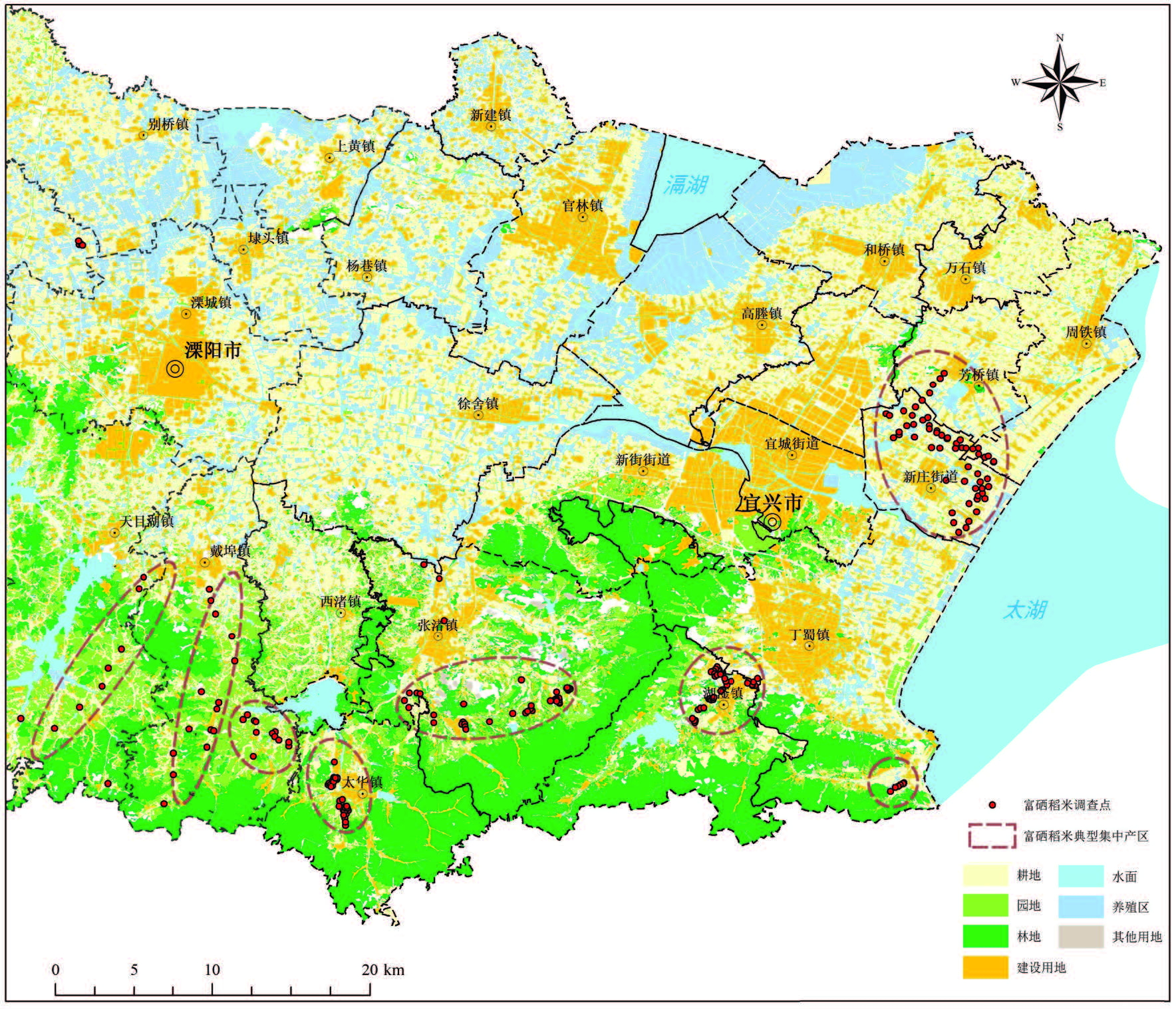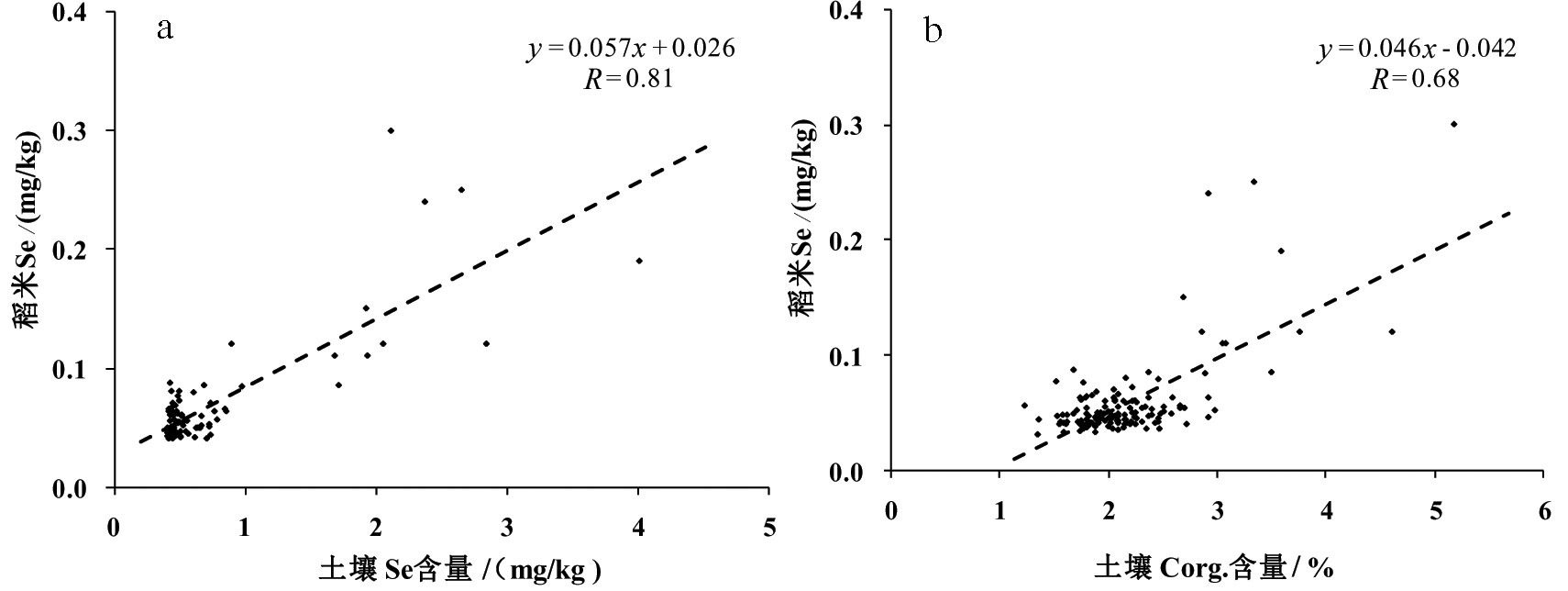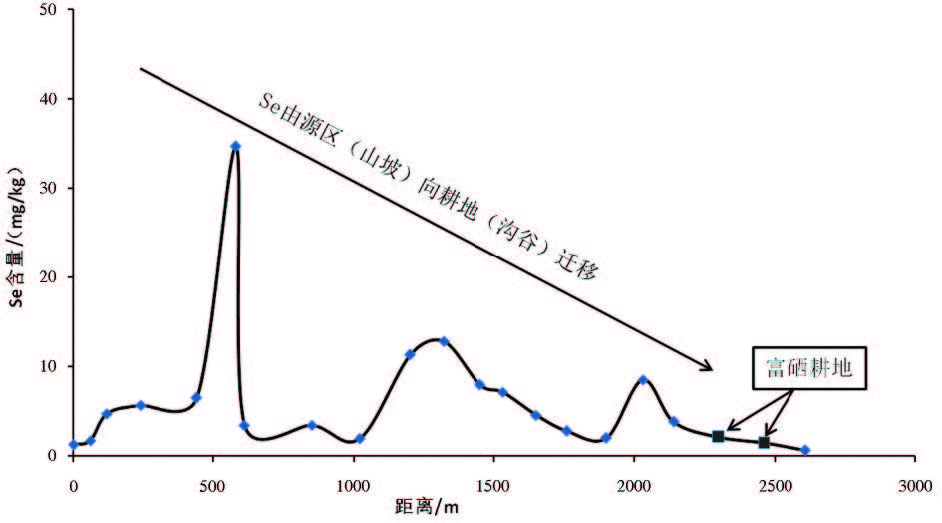Geological and geochemical background of Se-rich rice production in Yili area, Jiangsu Province
-
摘要:
江苏宜溧地区分布有400 km2多的富硒土壤,并产出天然富硒稻米。通过系统分析研究宜溧富硒稻米产地的稻米、土壤、岩石、水样的Se等元素地球化学数据,探讨了控制宜溧地区富硒稻米产出的主要地质环境及地球化学背景因素,总结了Se等元素在米-土-岩之间的分布迁移特征。结果显示:(1)宜溧地区产出的富硒稻米主要受富硒耕地控制,稻米Se与耕地土壤Se、Corg.之间存在显著正相关性,米Se与土Se的相关系数R=0.81,土壤Se≥0.5 mg/kg的耕地中富硒稻米检出率为100%;(2)二叠系煤系地层中的杂色泥质粉砂岩、页岩是主要富硒原岩,其平均Se含量达到17.22 mg/kg,比当地土壤中Se高出5倍以上。富硒原岩沉积厚度越大,其上覆土壤的Se含量越高;(3)上述富硒岩层中夹杂一层几到几十厘米厚的铁锰结核透镜状沉积物,富集Fe、Mn、Cd、S、P等,其风化形成土壤可能富集Cd,但富硒稻米中未检测到Cd超标;(4)耕地土壤中有效Se小于0.02 mg/kg,有效Se占土壤Se的比例为0.16%~2%。富硒耕地土壤总体偏酸性,其pH一般介于4.6~6.5,富硒原岩更偏酸性,其pH一般介于4.2~5.5;(5)Se从源头向耕地迁移也是一个不断均匀化的过程,地势、气候条件、断层等对富硒耕地的分布有影响,山间盆地、沟谷、山前平原是形成天然富硒耕地的主要场所,特定断层可成为天然富硒耕地的边界。
Abstract:There exist abundant Se-rich soil resources over 400 km2 in the Yili area, Jiangsu Province, and a part of natural Se-rich rice has been produced in this area. By systematically studying and analyzing newly-obtained elemental geochemical data from the typical samples about rice seeds, soil, rock and soil solution related to Se-rich rice origin, this paper discusses the main controlling factors and geological environment or geochemical background for producing the natural Se-rich rice in the Yili area, and summarizes distribution and migration characteristics of some trace elements such as Se within rice as well as soil and rock. Some conclusions have been reached:(1) Se concentration in rice is significantly correlated to Se and TOC in soil, with the correlation coefficient (R) being 0.81. Detection rate of Se-rich rice is 100% when Se concentration is more than 0.5 mg/kg in soil; (2) Permian coal-bearing strata seem to be main primitive sources to form Se-rich soil, and the variegated argillaceous siltstone and shale within the strata are important Se-rich rocks, and the average Se concentration is 17.22 mg/kg in these rocks, which is more than 5 times higher than the average Se concentration in the local soil; and there are some obvious positive correlation between rock thickness and Se concentration in its overlying soil:where the sedimentary thickness of the Se-rich rock increases, the Se concentration is higher in the overlying soil layer; (3) The above-mentioned Se-rich rock formation includes a layer of iron and manganese nodule sediments lenticular in form, its thickness is about 5-30 cm, and there are abundant Fe, Mn, Cd, S, P and some other elements in the nodule sediments; the weathering and transferring process to form soil may contain a part of Cd, but the Cd that exceeds the value of the standard sample has not been yet detected in those relevant Se-rich rice seeds; (4) the available Se concentration is lower than 0.02 mg/kg in the cultivated soil, and the ratio of the available Se concentration to Se concentration is from 0.16% to 2% or so in the cultivated soil; and the most cultivated soils that enrich selenium are acidic, their pH values are between 4.6 and 6.5; the original Se-rich rocks are more acidic, with their pH values being generally between 4.2 and 5.5; (5) Se migration process is a series of continuous dilutions or homogeneous movements. Se-rich farmland distribution is influenced by the terrain, rainfall, fault belt and some other factors. The natural Se-rich farmland is formed in the small basin in hills, valley and piedmont plain with fault belts becoming the natural boundary of Se-rich farmland.
-
Keywords:
- Se-rich rice /
- geological background /
- geochemistry /
- Yili area /
- Jiangsu Province
-
1. 引言
地下水氮污染是全球性的环境问题(Hu et al., 2005)。天然条件下,地下水中的氮尤其是铵态氮含量低,然而在城镇化进程中,受生活污水、工业废水、禽畜养殖场、化粪池及垃圾填埋场淋滤液泄漏影响,地下水中的铵态氮含量明显升高(刘兴权等,2010;杨静等,2018;徐进等,2018;苗晋杰等,2020)。地下水中NH4+质量浓度小于10 mg/L称为含铵地下水,NH4+质量浓度大于10 mg/L称为高铵地下水,而NH4+质量浓度超过30 mg/L的地下水称为高铵“肥水”(支兵发,2015)。高浓度的铵态氮对生活饮用水安全及生态环境存在潜在威胁。饮用水中的铵态氮会降低消毒效果,可转化为致癌的亚硝酸盐,也可转化为氨气引起水生物的死亡。此外,高铵地下水补给地表水会引起水生系统的富营养化(Du et al., 2017a)。高铵地下水的来源与成因是国内外学者研究的热点(支兵发,2015;杜尧,2017),城镇化地区高铵地下水铵氮来源复杂,相比较硝态氮和亚硝态氮,高浓度的铵态氮有各种人为来源,而天然沉积环境是造成高铵地下水的主要成因(Lingle et al., 2017;Du et al., 2017a)。
珠江三角洲是中国沿海地带经济飞速发展的地区。区内河网密布,地下水与地表水水力联系密切。工业化和城镇化的快速发展带来了地表水环境问题,同时对地下水环境也形成了潜在威胁。生活污水、工业废水无序排放,人畜粪便的淋滤下渗等导致地下水“三氮”污染突出,局部地区出现面状污染(Zhang et al., 2020)。高铵地下水在三角洲平原地区分布普遍,多赋存于洼地、谷地的第四系含水层底部。珠江三角洲高铵地下水基本形成于中全新世早期,与古海水的退积过程关系密切,迟缓的水循环条件和地下还原环境有利于高铵地下水的赋存(支兵发,2015)。然而,城镇化进程中,在原生沉积环境和人类活动双重作用下,研究区高铵地下水铵氮来源及赋存机制还鲜有报道。基于此,本文以珠江三角洲为研究区,综合多方面水文地质调查数据,运用数理统计、离子相关性分析等方法,探讨珠江三角洲地区高铵地下水赋存环境特征、驱动因素及城镇化扩张对三角洲地下水铵氮含量的影响。以期对珠江三角洲地区地下水资源的合理开发提供参考,也为沿海三角洲地区高铵地下水的研究提供借鉴。
2. 材料与研究方法
2.1 研究区水文地质概况
珠江三角洲地区位于广东省中南部,东、西、北三面低山、丘陵环绕,中南部为三角洲平原区陆地总面积约42000 km2。研究区属亚热带季风气候区,年平均气温23.2℃;年平均降水量1800~2200 mm,受季风气候影响,集中在4—9月。珠江三角洲属华南褶皱系粤北、粤中坳陷带;地层以泥盆系、石炭系、二叠系、侏罗系、第四系为主,其中第四系海陆交互相堆积物广泛分布于三角洲平原区。区内地下水可分为松散岩类孔隙水、碳酸盐岩类裂隙岩溶水、基岩裂隙水。三角洲冲洪积平原区以松散岩类孔隙水为主,厚度3~40 m,岩性以粗中砂及卵砾石为主,自下而上颗粒由粗变细。三角洲下部为晚更新世三角洲沉积前古河流沉积相砂砾层、砂质黏土层,上部为晚全新世泛滥平原相和三角洲沉积相砂质黏土、枯土、粉砂、细砂层,中部为早—中全新世陆相过渡到三角洲浅海相沉积淤泥或黏土层。大气降水、地表水以及灌溉回归渗水是地下水的主要补给来源。河流排泄、潜流排泄、人工开采和蒸发是地下水的主要排泄方式。地下水总体上自北向南,自北西向南东汇流,经珠江口和伶仃洋汇入南海(图 1,图 2)。
![]() 图 2 研究区水文地质剖面示意图1—砂;2—砂砾石;3—砂质黏土;4—黏质砂土;5—淤泥;6—黏土;7—砂岩;8—砂砾岩;9—粉砂质泥岩;10-页岩;11—泥灰岩;12—石灰岩;13—白云岩;14—片麻岩;15—混合岩;16—花岗岩;17—玄武岩;18—火山碎屑岩;19—水位埋深Figure 2. Hydrogeological profile of the study area1-Sand; 2-Sandy gravel; 3-Sandy clay; 4-Clay sand; 5-Silt; 6-Clay; 7-Sandstone; 8-Glutenite; 9-Sandy mudstone; 10-Shale; 11-Marl; 12-Limestone; 13-Dolomite; 14-Gneiss; 15-Migmatite; 16-Granite; 17-Basalt; 18-Pyroclastic rock; 19-Water level
图 2 研究区水文地质剖面示意图1—砂;2—砂砾石;3—砂质黏土;4—黏质砂土;5—淤泥;6—黏土;7—砂岩;8—砂砾岩;9—粉砂质泥岩;10-页岩;11—泥灰岩;12—石灰岩;13—白云岩;14—片麻岩;15—混合岩;16—花岗岩;17—玄武岩;18—火山碎屑岩;19—水位埋深Figure 2. Hydrogeological profile of the study area1-Sand; 2-Sandy gravel; 3-Sandy clay; 4-Clay sand; 5-Silt; 6-Clay; 7-Sandstone; 8-Glutenite; 9-Sandy mudstone; 10-Shale; 11-Marl; 12-Limestone; 13-Dolomite; 14-Gneiss; 15-Migmatite; 16-Granite; 17-Basalt; 18-Pyroclastic rock; 19-Water level2.2 研究区城镇化扩张
珠江三角洲是中国经济发展最快的三大经济单元之一,据广东统计年鉴(2020),近30 a来,珠江三角洲常驻人口从1988年的2370万人增加到2018年的6300万人,经济生产总值(GDP)由1988年的1007亿元增加到2018年的81049亿元。珠江三角洲工业化、城镇化发展迅速,建设用地扩张明显,由1988年的2600 km2增加到2018年的13100 km2.,扩大了4倍多。新增的建设用地主要为工业区,工业化快速发展和市政建设的滞后,给当地地下水环境带来严峻压力。城市生活污水、工业废水和垃圾渗滤液的下渗是研究区地下水水质恶化的重要影响因素(Huang et al., 2013;朱丹尼等,2018)(图 3)。
2.3 样品采集与分析
2016—2018年8—10月(本次研究)在研究区采集地下水样品1539组(图 1),搜集2005—2008年(首轮调查)历史水化学数据990组,两轮调查采集重复样品387组。样品取自民井、监测井和泉,采样井井深主要集中在0.2~40 m,地下水水位埋深0.05~15 m。采样设备主要有离心泵和潜水泵,采样前,对采样井进行抽水清洗,等排出水量大于井孔储水量3倍,并且电导率稳定后再进行采样,以确保采集的样品具有代表性。所用采样瓶为2.5 L的高密度聚乙烯瓶。取样后,贴标签并用Para film封口膜密封避光保存,7d内送达实验室测试。样品由自然资源部广东省物料实验检测中心测定,执行标准参照GB/T 8538-95。利用DX-120型离子色谱仪和ICP-AES分别对阴、阳离子进行测定,用纳氏试剂比色法对NH4+进行测定,用紫外分光光度法对NO3-进行测定,用ā-萘胺分光光度法对NO2-进行测定;现场测试指标酸碱度(pH)、溶解氧(DO)和氧化还原电位(Eh)等采用多功能便携式测试仪(Multi-340i/SET,德国WTW)进行测试。
2.4 研究方法
主成分分析是分析高维水化学数据的有利工具,其原理是通过线性组合对原始数据进行降维统计,提取少数几个主成分来分析控制水化学特征的天然及人为因素(Zhang et al., 2019)。吉布斯(Gibbs)图是利用半对数坐标图直观的表示了地表水化学组分特征、控制因素及其相互关系(Gibbs,1970)。本文运用舒卡列夫分类法分析水化学类型,运用SPSS、AquaChem等软件分析水化学数据,运用Gibbs图、离子比和主成分分析法探讨高铵地下水赋存特征及驱动因素。
3. 结果与讨论
3.1 高铵地下水赋存特征
3.1.1 不同城镇化水平地区高铵地下水分布特征
本次研究共采集地下水样品1539组,根据不同城镇化水平进行划分,林地、耕地、2008年前形成建设用地和2009—2018年新增建设用地4个单元分别采集地下水样品109组、374组、374组和681组(表 1)。其中,林地和耕地主要位于三角洲周缘丘陵台地区,城镇化建设用地主要位于三角洲平原区(图 1和图 3)。研究区浅层地下水NH4+质量浓度介于未检出~180 mg/L。1539组样品中,NH4+质量浓度大于10 mg/L的高铵地下水69组,其中包含NH4+质量浓度大于30 mg/L的高铵“肥水”23组。2008年前形成的城镇建设用地检出高铵水25组,检出率为6.7%;2009—2018年新增城镇建设用地检出高铵水44组,检出率为6.5%。不同时期形成的建设用地高铵地下水检出比例相近。然而,对比2005—2008年历史水化学数据,近10a来新增建设用地高铵地下水检出率增加25%,表明高铵地下水分布受人类活动影响较大。林地和耕地地下水中NH4+浓度较低,大于90% 的地下水样品点NH4+浓度集中在未检出~0.52 mg/L,均值分别为0.31mg/L和0.08 mg/L,均未检出高铵地下水。高铵地下水呈斑块状分布于城镇化快速发展的三角洲平原区第四系底部退积层序发育淤泥质含水层中。主要分布在广州南部、深圳、东莞等沿海地区和佛山顺德一带。西北江三角洲中部佛山—顺德为高铵“肥水”分布区,其中顺德北滘镇NH4+质量浓度最高达180 mg/L(图 1)。三角洲平原区上部及其周缘的丘陵台地区均未检出高铵地下水,表明高铵地下水的形成受控于第四系基底起伏形态、富含有机质的淤泥质的封闭-半封闭沉积环境(支兵发,2015)。
表 1 研究区不同城镇化水平区地下水化学组分统计表(mg/L)Table 1. Chemical composition of groundwater in various areas with different urbanization levels in the study area
3.1.2 高铵地下水的赋存环境特征
珠江三角洲浅层地下水总体上呈低溶解性总固体弱酸性特征(表 1),地下水中阳离子以Na+、Ca2+为主,阴离子以HCO3-、Cl-为主。研究区地下水总体上属于稳态水,略偏还原水(图 4)。研究区地下水pH值主要集中于4.72~7.76(图 4),酸化问题明显(Huang et al., 2018)。三角洲平原区高铵地下水pH值集中在6.17~8.73,高铵地下水氧化还原电位(Eh)集中在-217~12.7 mV。高铵地下水约70% 的样品氧化还原电位小于零,且高铵地下水中NH4+浓度与耗氧量(COD)呈显著的正相关关系(图 5)。表明低Eh高COD的中性—弱碱性还原环境有利于高铵地下水的赋存。研究区高铵地下水位于三角洲平原区,地下水径流缓慢,在阳离子交替吸附和蒸发浓缩作用下,地下水TDS含量明显升高。研究区高铵地下水起源于古海水,总体上以高溶解性总固体Cl-Na、HCO3·Cl-Na型水为主。
3.2 高铵地下水的成因分析
3.2.1 高铵地下水来源
地下水中的Na+、K+离子主要来源于大气降水、硅酸盐岩风化及蒸发盐岩溶解(左禹政等,2017;孙厚云等,2018;吕晓立等,2020)。钠氯系数(γNa+/γCl-)常作为成因系数判断地下水的来源、浓缩变质作用程度及水动力条件等(李建森等,2013;支兵发,2015)。海水中γNa+/γCl-比值约为0. 86,大气降水的γNa+/γCl-比值与海水相似。珠江三角洲沿海地区的大部分高铵“肥水”和部分高铵水样品点γNa+/γCl-比值接近于0.86(图 6),表明高铵地下水历史上受古咸水入侵形成。部分高铵水γNa+/γCl-比值大于1(图 6),说明高铵地下水形成过程中,在大气降水溶滤作用下,含钾钠岩石矿物风化溶解导致地下水中Na+、K+升高。部分样品γNa+/γCl-比值小于0.86(图 6),表明高铵地下水形成过程中Na+与Ca2+发生阳离子交替吸附作用而降低。
Ca2+/Na+、Mg2+/Na+和HCO3-/Na+等离子比值与地下水流动性及蒸发浓缩程度密切相关(Zhu et al., 2011;Xiao et al., 2012;Fan et al., 2014)。珠江三角洲高铵地下水样品主要集中在硅酸盐岩和蒸发盐岩控制端元之间且偏向硅酸盐岩控制端元(图 7),表明珠江三角洲地区高铵地下水的水化学主要受蒸发盐岩和硅酸盐岩的风化溶解作用控制。研究区大部分高铵水远离碳酸盐岩控制端元,说明高铵地下水化学组分受碳酸盐岩风化溶解作用影响较小。由Mg2+/Na+和HCO3-/Na+分布图 7可见,部分高铵“肥水”地下水Ca2+/Na+比值小于0.1,部分高铵水HCO3-/Na+比值小于0.1。受历史海咸水入侵、潮汐、水产养殖和人类活动多重因素驱动,分布于东莞、佛山、广州等沿海地区的高铵地下水化学组分以Na+为主,Ca2+/Na+比很低。
3.2.2 高铵地下水水化学演化过程
由Gibbs图(图 8)可见,研究区高铵地下水样品点主要分布在岩石风化和蒸发浓缩(海咸水入侵)两个区域,铵含量大于30 mg/L的“肥水”更靠近蒸发浓缩(海咸水入侵)区域。研究区高铵“肥水”的ρ(Na+)/ (ρ(Na+)+ρ(Ca2+))主要集中于0.5~0.98,TDS值介于498~11685 mg/L。进一步说明,研究区高铵地下水尤其是高铵“肥水”与海水具有相似的特征,高铵地下水的形成与历史上的海咸水入侵密切相关,表现为地下水TDS、Na+、Cl-同时升高。广州南部、深圳、东莞等沿海地区,处于地下水径流缓慢的排泄区,含水层为新统海冲积砂黏土,受阳离子交替吸附作用,地下水化学组分Na+/Ca2+比逐渐升高。
3.2.3 城镇化扩张对高铵地下水的影响
为探讨城镇化扩张对高铵地下水的影响,对比本次水化学数据与2005—2008年历史水化学数据,从387组重复样中选取铵氮污染单指标评价结果中超Ⅲ类水的样品点114组(其中,含本次水化学数据54组,2005—2008年水化学数据60组)与土地利用类型叠加,利用数理统计、箱型图分析不同时期不同城镇化水平铵态氮含量分布特征。由图 9可见,影响铵氮污染的土地利用类型主要为城镇建设用地。城镇化建设用地地下水中铵氮含量高,相应的箱型图表明数据离散程度高、高值点较多。尤其是2009—2018年近10年来的新增城镇建设用地,地下水铵态氮含量呈显著上升态势,地下水NH4+质量浓度中位值从十年前的2.6 mg/L增加到4.5 mg/L。相比之下,2008年以前形成的建设用地,近10年来地下水铵氮呈下降趋势,地下水中NH4+浓度中位值从2.9 g/L下降为2.2 g/L。这是由于近10年来,随着老城工业区的环境规划治理,很多分散污染企业统一规划搬迁到城郊工业区,老城区地下水NH4+浓度下降。另外,耕地和林地地下水中NH4+浓度呈上升趋势,耕地地下水中NH4+浓度中位值分别从1.2 g/L增加到1.5 g/L;林地地下水中铵氮浓度中位值从1.9 g/L增加到1.93 g/L。由此可见,地下水中铵态氮含量,建设用地明显高于耕地和林地。城镇化地区生活污水、工业废水的渗漏及耕地区化肥施加是引起NH4+浓度升高的重要因素。另外,三角洲平原区受原生沉积环境影响赋存高铵水。
3.2.4 人为活动输入
地下水中SO42-多来源于含硫矿物的溶解以及工矿活动、大气降尘引起的污染,而地下水中的氮主要来自农业活动含氮化肥的使用以及城市生活污水、垃圾渗滤液泄漏入渗。因此,常用SO42-/Ca2+、NO3-/Ca2+的比值关系来分析人类活动对地下水中主要离子的影响。如果SO42-/Ca2+比值高、NO3-/Ca2+比值低,则地下水可能受工矿活动的影响较大;反之,则可能受农业活动和生活污水的影响较大(蒲俊兵等,2010;朱亮等,2020)。相对于高铵水,研究区高铵“肥水”样品点SO42-/Ca2+和NO3-/Ca2+比值均较低,表明,高铵“肥水”处于封闭—半封闭环境,受人类活动影响较小。然而NH4+浓度大于10 mg/L的高铵水,SO42-/Ca2+和NO3-/Ca2+比值均较高(图 10)。表明在天然沉积环境与污染输入综合作用下,三角洲平原区形成了有利于高铵地下水赋存的还原环境。同时,在有机污染输入和微生物作用下,发生脱硫酸作用和有机质分解作用,促使地下水中NH4+离子浓度升高。
3.2.5 基于“主成分分析”的高铵地下水驱动因素
应用主成分分析法(PCA)对研究区高铵地下水主要离子间的关系进行分析,探讨高铵地下水的赋存特征及主要控制因素。本次研究选择影响地下水水质的17个主要水质参数(Na+、TDS、Cl-、Mg2+、总硬度、SO42-、K+、Ca2+、TFe、Mn2+、COD、NH4+、NO3-、NO2-、ORP、pH和HCO3-),对69组高铵地下水化学数据进行了KMO检验和Barlett球形检验,结果显示(表 2),KMO值为0.560,Barlett球形检验值为2859.302(P < 0.001)。基于特征值大于1的筛选要求,识别出引起珠江三角洲地区高铵地下水水质演化的4个主控因子,累积方差为85.610%。因子载荷矩阵详见表 2。
表 2 高铵地下水主要离子主成分分析Table 2. Principal component analysis of the major ions
第一主成分(PC1)的贡献率为38.160%,Na+、TDS、Cl-、Mg2+、总硬度、SO42-、K+、Ca2+与PC1表现出强正相关关系。蒸发岩盐溶解和海水入侵可为地下水中的K+、Na+、Ca2+、Mg2+、Cl-、SO42-提供重要来源,因此,PC1代表高铵地下水受蒸发盐岩溶解和海咸水入侵影响明显。第二主成分(PC2)的贡献率为23.818%,Fe、Mn、COD和NH4+呈显著正相关。PC2表明,在天然沉积环境和有机污染污染输入综合作用下,三角洲平原区形成了有利于高铵地下水赋存的还原环境。三角洲平原区孔隙含水层及上覆全新世—更新世弱透水层中富含的含氮有机质(Jiao et al., 2010),在封闭—半封闭的还原条件下,含氮有机物质矿化释放出大量的铵氮进入含水层。同时,受有机污染及微生物降解作用下,地层中的含Fe/Mn矿物还原为低价态Fe/Mn活化释放进入含水层。第三主成分(PC3)的贡献率为11.906%,ORP、NO3-和NO2-呈显著正相关,与NH4+呈弱负相关。表明在相对氧化环境下,易发生硝化作用,引起地下水硝酸盐的升高,不利于铵态氮的赋存。第四主成分(PC4)的贡献率为11.726%,HCO3-、pH值和NH4+呈较强—中等正相关关系,与氧化还原电位和NO3-有一定的负相关。该因子可视为还原环境因子,指示弱碱性还原环境有利于高铵地下水的赋存。
三角洲平原区孔隙水铵主要来源于淤泥层有机物的分解。在缺氧还原环境下,丰富的有机氮矿化分解为NH4+和HCO3-进入地下水,致使地下水中NH4+和HCO3-升高且呈正相关关系(Jiao et al., 2010)。因此笔者认为,淤泥层等富含有机质和总有机碳的沉积层是珠江三角洲地区的“生铵层”,有机氮的矿化是三角洲城镇老城区孔隙含水层中高铵地下水的主要驱动力。而位于三角洲周缘的河谷平原区城乡结合部孔隙含水层中高铵地下水可能来源于生活污水、垃圾填埋场以及农业污水灌溉等人为输入。城郊结合部地下水位埋深浅,包气带颗粒粗,地下水防污性能差;城镇化扩张致使该区人口密度逐渐增大,但排污管道还不健全,生活污水和人畜粪便的泄漏成为地下水中铵氮的重要来源。另外,该区分布大量的农业菜园,受富含铵的污水灌溉导致地下水中NH4+升高。
4. 结论
(1)珠江三角洲高铵地下水呈斑块状分布于三角洲平原区第四系底部低洼的基底、洼地等退积层序发育的淤泥质含水层中。三角洲平原区第四系富含有机质的淤泥层是三角洲的“生铵层”,有机氮的矿化是三角洲平原区城市化孔隙含水层中高铵地下水的主要驱动力。城镇化扩张中生活污水及富铵工业废水的泄漏入渗是城乡结合部高铵地下水中铵氮的另一重要来源。
(2)研究区高铵地下水化学演化受天然和人为因素双重作用影响,封闭—半封闭的沉积还原环境是三角洲高铵地下水的主要成因。然而城市化扩张生活污水、工业废水及垃圾渗滤液泄漏导致三角洲平原区地下水NH4+浓度的明显升高,城镇化和工业化是该区高铵地下水环境劣变恶化的强大驱动力。
致谢: 本研究得到了江苏省国土资源厅、地质调查研究院等领导的大力支持与指导帮助,参与该项研究的成员还包括翁志华、华明、汪媛媛、常青、李明等,在此一并诚致谢忱! -
表 1 研究区典型稻米及其土壤样品硒(Se)等分布统计
Table 1 Statistical results of Se content from some samples about Se-rich rice and its cultivated soil

表 2 典型富硒米产地土壤沉积柱样品分析结果(mg/kg)
Table 2 Analytical results (10-6) of the sedimentary soil core from the typical Se-rich site(mg/kg)

表 3 富硒稻米产地附近典型土壤-岩石垂直剖面采样分析结果
Table 3 Analytical results of rock and soil samples from some vertical profiles near the typical Se-rich rice site

-
[1] Tan J A,Huang Y J.Selenium in geo-ecosystem and its relations to endemic diseases in China[J].Water,Air,Soil Pollut.,1991,57:59-68. http://cn.bing.com/academic/profile?id=2066974703&encoded=0&v=paper_preview&mkt=zh-cn
[2] Rotruer J T,Poue A L.Se biochemical role as a component of glutathione peroxidase[J].Science,1993,179:588-596. http://cn.bing.com/academic/profile?id=2060194897&encoded=0&v=paper_preview&mkt=zh-cn
[3] Fordyce F M,Johnson C C,Navaratne U R B,et al.Selenium and Iodine in soil,rice and drinking water in relation to endemic goiter in Sri Lanka[J].Science of the Total Environment,2000,263:127-142. doi: 10.1016/S0048-9697(00)00684-7
[4] Rayman M.The importance of Selenium to human health[J].Lancet,2000,356:233-241. doi: 10.1016/S0140-6736(00)02490-9
[5] Hatikainen H.Biochemistry of selenium and its impact on food chain quality and human health[J].J.Trace.Elem.Med.Biol.,2005,18:309-318. doi: 10.1016/j.jtemb.2005.02.009
[6] Letavayova L,Vlckova V,Brozmanova J.Selenium:from cancer prevention to DNA damage[J].Toxicology,2006,227:1-14. doi: 10.1016/j.tox.2006.07.017
[7] Eiliv Steinnes.Soils and geomedicine[J].Environ.Geochem.Health,2009,31:523-535. doi: 10.1007/s10653-009-9257-2
[8] 石爱华,彭祚全,张姸艳,等.我国富硒大米的研究与开发[J].微量元素与健康研究,2015,32(1):31-32. http://www.cnki.com.cn/Article/CJFDTOTAL-WYJK201501021.htm Shi Aihua,Peng Zuoquan,Zhang Yanyan,et al.Research and development to Se-enriched rice in China[J].Studies of Trace Elements and Health,2015,32(1):31-32(in Chinese). http://www.cnki.com.cn/Article/CJFDTOTAL-WYJK201501021.htm
[9] 岳士忠,李圣男,乔玉辉,等.中国富硒大米的生产与富硒效应[J],中国农业通报,2015,31(10):10-15. http://www.cnki.com.cn/Article/CJFDTOTAL-ZNTB201530003.htm Yue Shizhong,Li Shengnan,Qiao Yuhui,et al.Studies on Seenriched rice production and the effect of Se-enrichment[J].Chinese Agricultural Science Bulletin,2015,31(10):10-15(in Chinese with English abstract). http://www.cnki.com.cn/Article/CJFDTOTAL-ZNTB201530003.htm
[10] 胡秋辉,潘根兴,安辛欣,等.天然和人工富硒茶叶的抗氧化功能比较[J].营养学报,2001,23(3):242-245. http://www.cnki.com.cn/Article/CJFDTOTAL-YYXX200103013.htm Hu Qiuhui,Pan Genxing,An Xinxin,et al.Comparison of antioxidant function of teas naturally high in selenium and artificially Se-en riched in rats[J].Acta Nutrimenta Sinica,2001,23(3):242-245(in Chinese with English abstract). http://www.cnki.com.cn/Article/CJFDTOTAL-YYXX200103013.htm
[11] 张光弟,葛晓立,张绮玲,等.湖北恩施地区硒的地质地球化学背景[J].地球学报,1998,19(1):59-67. http://www.cnki.com.cn/Article/CJFDTOTAL-DQXB801.007.htm Zhang Guangdi,Ge Xiaoli,Zhang Qiling,et al.Selenium geological and geochemical environmental background in Enshi,Hube[J].Acta Geoscientia Sinica,1998,19(1):59-67(in Chinese with English abstract) http://www.cnki.com.cn/Article/CJFDTOTAL-DQXB801.007.htm
[12] 廖启林,金洋,吴新民,等.南京地区土壤元素的人为活动环境富集系数研究[J],中国地质,2005,32(1):141-147. http://geochina.cgs.gov.cn/ch/reader/view_abstract.aspx?file_no=20050119&flag=1 Liao Qilin,Jin Yang,Wu Xinmin,et al.The artificial environmental concentration coefficient of elements from topsoil in Nanjing areas[J].Geology in China,2005,32(1):141-147(in Chinese with English abstract). http://geochina.cgs.gov.cn/ch/reader/view_abstract.aspx?file_no=20050119&flag=1
[13] 姚德,孙梅,杨富贵,等.青岛城区土壤重金属环境地球化学研究[J].中国地质,2008,35(3):539-550. http://geochina.cgs.gov.cn/ch/reader/view_abstract.aspx?file_no=20080319&flag=1 Yao De,Sun Mei,Yang Fugui,et al.Environmental geochemistry of heavy metals in urban soils of Qingdao City[J].Geology in China,2008,35(3):539-550(in Chinese with English abstract). http://geochina.cgs.gov.cn/ch/reader/view_abstract.aspx?file_no=20080319&flag=1
[14] 崔刑涛,栾文楼,石少坚,等.石家庄污灌区土壤元素评价[J].中国地质,2010,37(6):1753-1759. http://geochina.cgs.gov.cn/ch/reader/view_abstract.aspx?file_no=20100622&flag=1 Cui Xintao,Luan Wenlou,Shi Shaojian,et al.The evaluation of soil elements in topsoil of the sewage irrigation area in Shijiazhuang[J].Geology in China,2010,37(6):1753-1759(in Chinese with English abstract). http://geochina.cgs.gov.cn/ch/reader/view_abstract.aspx?file_no=20100622&flag=1
[15] 管后春,李运怀,彭苗芝,等.黄山城市土壤重金属污染及其潜在生态风险评价[J].中国地质,2013,40(6):1949-1958. http://geochina.cgs.gov.cn/ch/reader/view_abstract.aspx?file_no=20130624&flag=1 Guan Houchun,Li Yunhuai,Peng Miaozhi,et al.The evaluation of heavy metal pollution and its potential ecological risk of urban topsoil in Huangshan City[J].Geology in China,2013,40(6):1949-1958(in Chinese with English abstract). http://geochina.cgs.gov.cn/ch/reader/view_abstract.aspx?file_no=20130624&flag=1
[16] 王文俊.福建省寿宁县1:25万土地质量地球化学评估[J].中国地质,2014,41(2):665-674. http://geochina.cgs.gov.cn/ch/reader/view_abstract.aspx?file_no=20140227&flag=1 Wang Wenjun.1:250000 land quality geochemical assessment of Shouning County,Fujian Province[J].Geology in China,2014,41(2):665-674(in Chinese with English abstract). http://geochina.cgs.gov.cn/ch/reader/view_abstract.aspx?file_no=20140227&flag=1
[17] 代杰瑞,祝德成,庞绪贵,等.济南市土壤元素地球化学特征及环境质量[J].中国地质,2015,42(1):308-316. http://geochina.cgs.gov.cn/ch/reader/view_abstract.aspx?file_no=20150124&flag=1 Dai Jierui,Zhu Decheng,Pang Xugui,et al.Geochemical characteristics and environmental quality of soil elements in Jinan City[J].Geology in China,2015,42(1):308-316(in Chinese with English abstract). http://geochina.cgs.gov.cn/ch/reader/view_abstract.aspx?file_no=20150124&flag=1
[18] 崔邢涛,王学求,栾文楼.河北中南部平原土壤重金属元素存在形态及生物有效性分析[J].中国地质,2015,42(2):655-663. http://geochina.cgs.gov.cn/ch/reader/view_abstract.aspx?file_no=20150223&flag=1 Cui Xingtao,Wang Xuqiu,Luan Wenlou.An analysis of modes of occurrence and biological availability of the heavy metal elements in soil of the central and southern plain in Hebei[J].Geology in China,2015,42(2):655-663(in Chinese with English abstract). http://geochina.cgs.gov.cn/ch/reader/view_abstract.aspx?file_no=20150223&flag=1
[19] 廖启林,华明,金洋,等.江苏省土壤重金属分布特征与污染源初步研究[J].中国地质,2009,36(5):1163-1174. http://geochina.cgs.gov.cn/ch/reader/view_abstract.aspx?file_no=20090520&flag=1 Liao Qilin,Hua Ming,Jin Yang,et al.A preliminary study of the distribution and pollution sources of heavy metals in soils of Jiangsu Province[J].Geology in China,2009,36(5):1163-1174(in Chinese with English abstract). http://geochina.cgs.gov.cn/ch/reader/view_abstract.aspx?file_no=20090520&flag=1
[20] 廖启林,刘聪,蔡玉曼,等.江苏典型地区水稻与小麦籽实中元素生物富集系数(BCF)初步研究[J].中国地质,2013,40(1):330-339. Liao Qilin,Liu Cong,Cai Yuman,et al.A preliminary study of element bioconcentration factors within milled rice and wheatmeal in some typical areas of Jiangsu Province[J].Geology in China,2013,40(1):330-339(in Chinese with English abstract).
[21] 廖启林,刘聪,王轶,等.水稻吸收Cd的地球化学控制因素研究——以苏锡常典型区为例[J].中国地质,2015,42(5):1212-1223. http://www.cnki.com.cn/Article/CJFDTOTAL-DIZI201301025.htm Liao Qilin,Liu Cong,Wang Yi,et al.Geochemical characteristics of rice uptake of cadmium and its main controlling factors:A case study of the Suxichang (Suzhou-Wuxi-Changzhou) typical area[J].Geology in China,2015,42(5):1212-1223(in Chinese with English abstract). http://www.cnki.com.cn/Article/CJFDTOTAL-DIZI201301025.htm
[22] 廖启林,华明,冯金顺,等.苏南局部富硒土壤及其天然富硒茶叶初步研究[J].中国地质,2007,34(2):347-353. Liao Qilin,Hua Ming,Feng Jinshun,et al.Natural Se-rich tea in local Se-rich soils in southern Jiangsu[J].Geology in China,2007,34(2):347-353(in Chinese with English abstract).
[23] Zhu Jianming,Thomas M,Robert B,et al.The occurrence and origin of selenium minerals in Se-rich stone coals,spoils and their adjacent soils in Yutangba,China[J].Chemical Geology,2012,330-331:27-38. doi: 10.1016/j.chemgeo.2012.08.023
[24] 张光弟,葛晓立,张绮玲,等.湖北恩施硒中毒区土壤硒的分布及其控制因素[J].中国地质,2001,28(9):37-40. http://www.cnki.com.cn/Article/CJFDTOTAL-DIZI200109005.htm Zhang Guangdi,Ge Xiaoli,Zhang Qiling,et al.Se distribution and its control factor in soil polluted by selenium in Enshi,Hubei[J].Geology in China,2001,28(9):37-40(in Chinese). http://www.cnki.com.cn/Article/CJFDTOTAL-DIZI200109005.htm
[25] 雒昆利,潘云唐,王五一.南秦岭早古生代地层含硒量及硒的分布规律[J].地质论评,2001,47(2):211-217. http://www.cnki.com.cn/Article/CJFDTOTAL-DZLP200102018.htm Luo Kunli,Pan Yuntang,Wang Wuyi.Selenium content and distribution pattern in the Palaeozoic strata in the Southern Qinling Mountains[J].Geological Review,2001,47(2):211-217(in Chinese with English abstract). http://www.cnki.com.cn/Article/CJFDTOTAL-DZLP200102018.htm
[26] Sun Weixia,Huang Biao,Zhao Yongcun,et al.Spatial variability of soil selenium as affected by geologic and pedogenic processes and its effect on ecosystem and human health[J].Geochemical Journal,2009,43:217-225. doi: 10.2343/geochemj.1.0019
[27] Cao Z H,Wang X C,Yao D H,et al.Selenium geochemistry of paddy soils in Yangtze River Delta[J].Environment International,2011,26:335-339. http://cn.bing.com/academic/profile?id=2089858101&encoded=0&v=paper_preview&mkt=zh-cn
[28] Johnsson,L.Selenium uptake by plants as a function of soil type,organic matter content and pH[J].Plant Soil,1991,133:57-64. doi: 10.1007/BF00011899
[29] 金兴钰,王胜华,包雨函,等.成都经济区土壤及经济植物硒含量特征[J].成都理工大学学报(自然科学版),2010,37(3):322-331. http://www.cnki.com.cn/Article/CJFDTOTAL-CDLG201003016.htm Jin Xingyu,Wang Shenghua,Bao Yuhan,et al.Survey and research of selenium content in soil and economic plants from the Chengdu economic areas,Sichuan,China[J].Journal of Chengdu University of Technology (Science & Technology Edition),2010,37(3):322-331(in Chinese with English abstract). http://www.cnki.com.cn/Article/CJFDTOTAL-CDLG201003016.htm
[30] 郑达贤,李日邦,谭见安.土壤-植物系统硒传输的研究[J].地球科学,1986,6(1):22-33. Zheng Daxian,Li Ribang,Tan Jianan.Study on transport of Selenium in sosil-plant system[J].Earth Sciences,1986,6(1):22-33(in Chinese with English abstract)
[31] 张艳玲,潘根兴,李正文,等.土壤-植物系统中硒的迁移转化及低硒地区食物链中硒的调节[J].土壤与环境,2002,11(4):388-391. http://www.cnki.com.cn/Article/CJFDTOTAL-TRYJ200204015.htm Zhang Yanling,Pan Genxing,Li Zhengwen,et al.Translation of Selenium in the sestem of soil-plant and its regulation in foodchain[J].Soil and Environmrntal Sciencs,2002,11(4):388-391(in Chinese with English abstract). http://www.cnki.com.cn/Article/CJFDTOTAL-TRYJ200204015.htm
[32] 蔡子华,宋明义,胡艳华,等.湖沼相富硒土壤的发现及其生态学意义J].物探与化探,2011,35(2):248-253. http://cn.bing.com/academic/profile?id=2385005787&encoded=0&v=paper_preview&mkt=zh-cn Cai Zihua,Song Mingyi,Hu Yanhua,et al.The discovery of lake facies Selenium-rich soil and its ecological significance[J].Geophysical and Geocgemical Exploration,2011,35(2):248-253(in Chinese with English abstract). http://cn.bing.com/academic/profile?id=2385005787&encoded=0&v=paper_preview&mkt=zh-cn
[33] 侯现慧,王占岐,杨俊.富硒区耕地质量评价及利用分区研究——以福建省三元区为例[J].资源科学,2015,37(7):1367-1375. http://www.cnki.com.cn/Article/CJFDTOTAL-ZRZY201507008.htm Hou Xianhui,Wang Zhanqi,Yang Jun.Cultivated land quality evalution using paitition in the selenium-rich area of Sanyuan,Fujian Province[J].Resources Science,2015,37(7):1367-1375(in Chinese with English abstract). http://www.cnki.com.cn/Article/CJFDTOTAL-ZRZY201507008.htm
[34] Feng Renwei,Wei Chaoyang,Tu Shuxin,et al.A dual role of Se on Cd toxicity:Evidences from uptake of Cd and some essential elements and the growth responses in paddy rice[J].Biol.Trace Elem.Res.,2012,151:113-121. http://cn.bing.com/academic/profile?id=2016083999&encoded=0&v=paper_preview&mkt=zh-cn




 下载:
下载:














